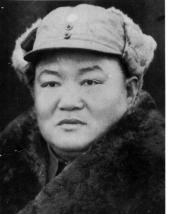During the Period of the War of Liberation, the Yimengshan Liberated Area made great contributions to the victory of the Chinese revolution. During this period, Luo Binghui, commander of the Second Column of the Central China Field Army, led his troops with other units in less than a year in the Lunan area, annihilated more than 10,000 enemy troops in three battles, and became a god of war in our army during the Liberation War.

Luo Binghui was born in December 1897 in Yiliang, Yunnan. In 1915, he joined the Dian Army as a soldier, fought bravely, rose from soldier to battalion commander, and participated in the War of Defending the Yuan Dynasty, the War of the Eastern Crusade and the Northern Expedition. In July 1929, he secretly joined the Communist Party of China, and in November of the same year, he led the jingwei brigade soldiers in an uprising in Ji'an, Jiangxi Province, and joined the Chinese Workers' and Peasants' Red Army.
At the beginning of the War of Resistance Against Japanese Aggression, in the name of the deputy chief of staff of the Eighth Route Army, he engaged in united front work in the Wuhan office of the Eighth Route Army. In 1939, he was appointed deputy commander of the 1st detachment and commander of the 5th detachment of the New Fourth Army, and led the unit to open up the anti-Japanese base area in eastern Anhui. After 1940, he served as the deputy commander of the Jiangbei Command, the commander of the 5th Detachment, the deputy commander of the 2nd Division, and from 1943, he served as the commander of the 2nd Division and the commander of the Huainan Military Region.
Luo Binghui's family took a group photo in Linyi
In September 1945, he was appointed commander of the second column of the Central China Field Army, and in November, he led his troops into the Lunan area to block the Kuomintang northern offensive army, annihilating 4 enemy divisions and capturing more than 4,000 people under the enemy's deputy division commander Yu Huai'an. On November 8, together with Chen Yi, he commanded the second column to annihilate more than 2,000 enemy troops. In April 1946, he was appointed as the second deputy commander of the New Fourth Army and the second deputy commander of the Shandong Military Region, and on June 9, he commanded the second column to attack the Kuomintang troops entrenched in Zaozhuang, annihilating more than 4,000 enemy troops, creating favorable conditions and time for the main force of the Shandong Eighth Route Army to march northeast, and thwarting the Kuomintang plan to open the Jinpu Road. Due to years of conquest and overwork, he died of illness in Linyi, Shandong Province on June 21, 1946, and was buried in Linyi at the age of 49. In 1949, Luo Binghui was buried in the Linyi East China Revolutionary Martyrs Cemetery.
He was one of the 36 military experts of the People's Liberation Army recognized by the Central Military Commission after the founding of the People's Republic of China, and was named one of the 100 heroic models who made outstanding contributions to the founding of New China.
Luo Binghui is a sharpshooter. It is rumored that during the War of Resistance Against Japanese Aggression, he killed three Japanese soldiers with one bullet. How did he do it? The first two were pierced through the chest, the third devil was shot through the head, and the bullet passed through the head and then hit the arm of the fourth Japanese soldier.
In order to commemorate this god of war who worked hard for the establishment of new China, the "Zhan Rong Si Gong Pavilion" (also known as the Stone Statue Pavilion of General Luo Binghui) and the Tomb of Luo Binghui Martyrs were built in the East China Revolutionary Martyrs' Cemetery. Inside the Pavilion is a statue of Luo Binghui.
Zhan Rong Si Gong Pavilion
Statue of Luo Binghui in the Pavilion of Zhan Rong Si Gong
The top of the tomb is decorated with medals won by the general in the five anti-"encirclement and suppression" campaigns, and the inscriptions of leaders such as Liu Shaoqi, Zhu De, Zhou Enlai, and Ren Bishi are engraved around the tomb. There are also four small reliefs, showing General Luo Binghui's love for soldiers, concern for the masses, the formulation of combat plans, and in-depth frontline command.
Tomb of Luo Binghui